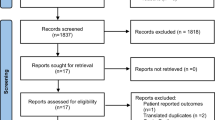Abstract
Background
The short-term results of the Sigma trial show that laparoscopic sigmoid resection (LSR) used electively for diverticular disease offers advantages over open sigmoid resection (OSR). This study aimed to compare the overall mortality and morbidity rates after evaluation of the clinical outcomes at the 6-month follow-up evaluation.
Methods
In a prospective, multicenter, double-blind, parallel-arm, randomized control trial, eligible patients were randomized to either LSR or OSR. The short-term results and methodologic details have been published previously. Follow-up evaluation was performed at the outpatient clinic 6 weeks and 6 months after surgery.
Results
In this trial, 104 patients were randomized for either LSR or OSR, and the conversion rate was 19.2%. The LSR approach was associated with short-term benefits such as a 15.4% reduction in the major complications rate, less pain, and a shorter hospital stay at the cost of a longer operating time. At the 6-month follow-up evaluation, no significant differences in morbidity or mortality rates were found. Two patients died of cardiac causes (overall mortality, 3%). Late complications (7 LSR vs. 12 OSR; p = 0.205) consisted of three incisional hernias, five small bowel obstructions, four enterocutaneous fistulas, one intraabdominal abscess, one retained gauze, two anastomotic strictures, and three recurrent episodes of diverticulitis. Nine of these patients underwent additional surgical interventions. Consideration of the major morbidity over the total follow-up period (0–6 months) shows that the LSR patients experienced significantly fewer complications than the OSR patients (9 LSR vs. 23 OSR; p = 0.003). The Short Form-36 (SF-36) questionnaire showed significantly better quality of life for LSR at the 6-week follow-up assessment. However, at the 6-month follow-up assessment, these differences were decreased.
Conclusions
The late clinical outcomes did not differ between LSR and OSR during the 30-day to 6-month follow-up period. Consideration of total postoperative morbidity shows a 27% reduction in major morbidity for patients undergoing laparoscopic surgery for diverticular disease.

Similar content being viewed by others
References
Alves A, Panis Y, Slim K, Heyd B, Kwiatkowski F, Mantion G (2005) French multicentre prospective observational study of laparoscopic versus open colectomy for sigmoid diverticular disease. Br J Surg 92:1520–1525
Schwandner O, Farke S, Fischer F, Eckmann C, Schiedeck TH, Bruch HP (2004) Laparoscopic colectomy for recurrent and complicated diverticulitis: a prospective study of 396 patients. Langenbecks Arch Surg 389:97–103
Oomen JL, Engel AF, Cuesta MA (2006) Outcome of elective primary surgery for diverticular disease of the sigmoid colon: a risk analysis based on the POSSUM scoring system. Colorectal Dis 8:91–97
Chapman J, Davies M, Wolff B, Dozois E, Tessier D, Harrington J, Larson D (2005) Complicated diverticulitis: is it time to rethink the rules? Ann Surg 242:576–581
Salem TA, Molloy RG, O’Dwyer PJ (2007) Prospective, five-year follow-up study of patients with symptomatic uncomplicated diverticular disease. Dis Colon Rectum 50:1460–1464
Rafferty J, Shellito P, Hyman NH, Buie WD (2006) Practice parameters for sigmoid diverticulitis. Dis Colon Rectum 49:939–944
Scheidbach H, Schneider C, Rose J, Konradt J, Gross E, Barlehner E, Pross M, Schmidt U, Kockerling F, Lippert H (2004) Laparoscopic approach to treatment of sigmoid diverticulitis: changes in the spectrum of indications and results of a prospective, multicenter study on 1,545 patients. Dis Colon Rectum 47:1883–1888
Etzioni DA, Mack TM, Beart RW Jr, Kaiser AM (2009) Diverticulitis in the United States: 1998–2005: changing patterns of disease and treatment. Ann Surg 249:210–217
Jones OM, Stevenson AR, Clark D, Stitz RW, Lumley JW (2008) Laparoscopic resection for diverticular disease: follow-up of 500 consecutive patients. Ann Surg 248:1092–1097
Klarenbeek BR, Veenhof AA, Bergamaschi R, van der Peet DL, van den Broek WT, de Lange ES, Bemelman WA, Heres P, Lacy AM, Engel AF, Cuesta MA (2009) Laparoscopic sigmoid resection for diverticulitis decreases major morbidity rates: a randomized control trial: short-term results of the Sigma trial. Ann Surg 249:39–44
Klarenbeek BR, Veenhof AA, de Lange ES, Bemelman WA, Bergamaschi R, Heres P, Lacy AM, van de Broek WT, van der Peet DL, Cuesta MA (2007) The Sigma trial protocol: a prospective double-blind multicentre comparison of laparoscopic versus open elective sigmoid resection in patients with symptomatic diverticulitis. BMC Surg 7:16
Aaronson NK, Muller M, Cohen PD, Essink-Bot ML, Fekkes M, Sanderman R, Spranger MA, te Velde A, Verrips E (1998) Translation, validation, and norming of the Dutch language version of the SF-36 Health Survey in community and chronic disease populations. J Clin Epidemiol 51:1055–1068
Oomen JL, Cuesta MA, Engel AF (2005) Reversal of Hartmann’s procedure after surgery for complications of diverticular disease of the sigmoid colon is safe and possible in most patients. Dig Surg 22:419–425
Collins D, Winter DC (2008) Elective resection for diverticular disease: an evidence-based review. World J Surg 32:2429–2433
Wong WD, Wexner SD, Lowry A, Vernava A III, Burnstein M, Denstman F, Fazio V, Kerner B, Moore R, Oliver G, Peters W, Ross T, Senatore P, Simmang C (2000) Practice parameters for the treatment of sigmoid diverticulitis—supporting documentation. The Standards Task Force. The American Society of Colon and Rectal Surgeons. Dis Colon Rectum 43:290–297
Disclosures
Bastiaan R. Klarenbeek, Roberto Bergamaschi, Alexander A. F. A. Veenhof, Donald L. van der Peet, Wim T. van den Broek, Elly S. M. de Lange, Willem A. Bemelman, Pieter Heres, Antonio M. Lacy, and Miguel A. Cuesta have no conflicts of interest or financial ties to disclose.
Author information
Authors and Affiliations
Corresponding author
Rights and permissions
About this article
Cite this article
Klarenbeek, B.R., Bergamaschi, R., Veenhof, A.A.F.A. et al. Laparoscopic versus open sigmoid resection for diverticular disease: follow-up assessment of the randomized control Sigma trial. Surg Endosc 25, 1121–1126 (2011). https://doi.org/10.1007/s00464-010-1327-0
Received:
Accepted:
Published:
Issue Date:
DOI: https://doi.org/10.1007/s00464-010-1327-0




